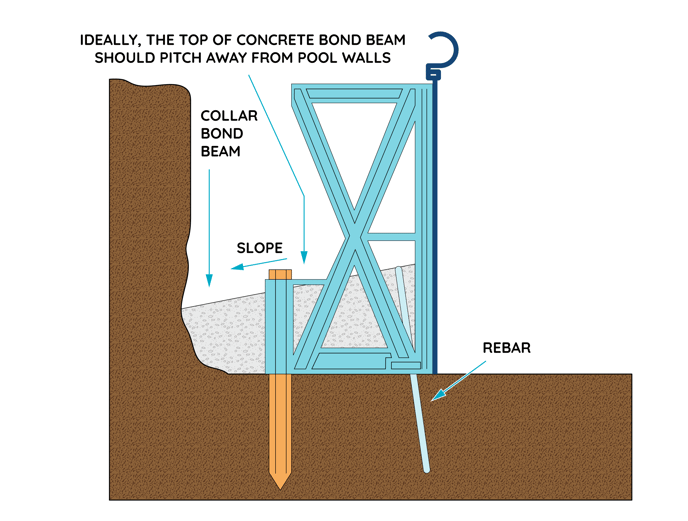Check the wall panels one final time for proper level. To avoid the concrete footing (bond beam) from running under wall sections and protruding into pool excavation, be sure to fill any voids under the wall with dirt...
Check the wall panels one final time for proper level. To avoid the concrete footing (bond beam) from running under wall sections and protruding into pool excavation, be sure to fill any voids under the wall with dirt.
Place the concrete behind the wall gently being careful not to direct the flow of concrete directly at the panels. A little extra care and patience at this stage is recommended. Extra concrete should be concentrated at the A-Frames and corners.
Pour a minimum 2500 PSI - ¾" stone concrete footing mixture (pea gravel stone is also suitable for this job) around the entire pool panel perimeter, at a depth of 5" to 7" and at least 30" wide. Footers deeper than this are unnecessary and may result in bowed or crooked walls.
TIP: Smoothing out the footing with a trowel or shovel will provide more suitable bedding for the plumbing to set upon.
|
AMOUNT OF CONCRETE NEEDED |
|
|
POOL SIZE |
YARDS OF CONCRETE |
|
12 x 24 |
3½ Yards |
|
14 x 28 |
4 Yards |
|
16 x 32 |
5 Yards |
|
18 x 36 |
6 Yards |
|
20 x 40 |
7 Yards |
You’ll want to make sure to order an extra ½ yard for each step/swim-out.
For the pad for the filter, pump and heater, take the square footage of the desired pad size and divide it by 30.
Add that number to the yardage required in the table to get the most accurate amount of concrete.
For example: If the size of your pad needs to be 40 square feet, divided by 30 that would equal 1.33.
You would add 1.33 yards to the number of yards of concrete shown in the table for your specific pool's size.

Continue to the next installation step: How to Pour the Concrete Footing for your Inground Pool
Didn't find the answer you were looking for? You can always contact us at support@royalswimmingpools.com or choose the category below to see our most frequently asked questions for that topic:
